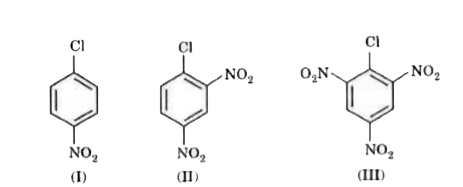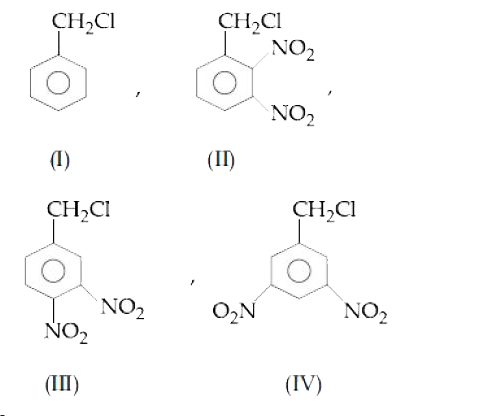Increasing order of reactivity of the following compounds for SN1 substitution is :

(B)<(C)<(D)<(A)
(A)<(B)<(D)<(C)
(B)<(A)<(D)<(C)
(B)<(C)<(A)<(D)
The correct Answer is:C
Reactivity order on the basis of stability of carbocation:

Topper's Solved these Questions
- HALOALKANES AND HALOARENESBOOK - MODERN PUBLICATIONCHAPTER - HALOALKANES AND HALOARENESEXERCISE - C. MULTIPLE CHOICE QUESTIONS (with more than one correct answers)
10 Videos
- HALOALKANES AND HALOARENESBOOK - MODERN PUBLICATIONCHAPTER - HALOALKANES AND HALOARENESEXERCISE - D. MULTIPLE CHOICE QUESTIONS (based on the given passage / comprehension)
9 Videos
- HALOALKANES AND HALOARENESBOOK - MODERN PUBLICATIONCHAPTER - HALOALKANES AND HALOARENESEXERCISE - A. MULTIPLE CHOICE QUESTIONS (with only one correct answer)
35 Videos
- EQUILIBRIUMBOOK - MODERN PUBLICATIONCHAPTER - EQUILIBRIUMEXERCISE - Unit Practice Test
13 Videos
- HYDROCARBONSBOOK - MODERN PUBLICATIONCHAPTER - HYDROCARBONSEXERCISE - UNIT PRACTICE TEST
15 Videos
Similar Questions
Knowledge Check
The increasing order of reactivity of the following bromides in SN1 reaction is
 AIV>III>I>IIBIII>IV>I>IICII>III>I>IVDII>III>IV>I
AIV>III>I>IIBIII>IV>I>IICII>III>I>IVDII>III>IV>IWhat is the order of reactivity of the following compounds towards nucleophilic substitution?
 AI<II<III<IVBIV<III<II<ICIV<I<II<IIIDIV<II<I<III
AI<II<III<IVBIV<III<II<ICIV<I<II<IIIDIV<II<I<III
Predict the order of reactivity of the following compounds in SN1 reactions :

View SolutionPredict the order of reactivity of the following compounds in SN1 reactions :

View SolutionPredict the order of reactivity of the following compounds in SN1 reactions :

View SolutionAryl halides are extremely less reactive towards nucleophilie substitution. Predict and explain the order of reactivity of the following compounds towards nucleophilic substitution:

View SolutionAryl halides are extremely less reactive towards nucleophilie substitution. Predict and explain the order of reactivity of the following compounds towards nucleophilic substitution:

View SolutionWhat is the order of reactivity of the following compounds towards nucleophilic substitution?

View Solution


